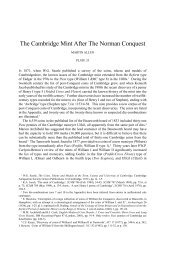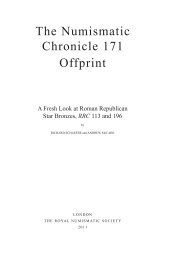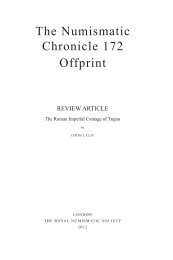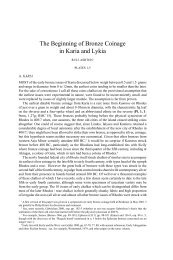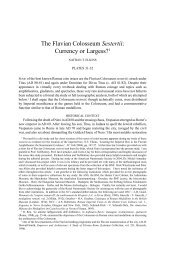Iolkos and Pagasai: Two New Thessalian Mints* - Royal Numismatic ...
Iolkos and Pagasai: Two New Thessalian Mints* - Royal Numismatic ...
Iolkos and Pagasai: Two New Thessalian Mints* - Royal Numismatic ...
You also want an ePaper? Increase the reach of your titles
YUMPU automatically turns print PDFs into web optimized ePapers that Google loves.
IOLKOS AND PAGASAI 35<br />
parallels with the coins of Orthagoreia <strong>and</strong> of Philip II. They are unlikely to be<br />
commemorative coinages, which were normally struck in precious metal,<br />
though the discovery of silver coins of <strong>Iolkos</strong> <strong>and</strong> <strong>Pagasai</strong> in the future cannot of<br />
course be ruled out. <strong>Iolkos</strong> is not recorded in the ancient sources as being<br />
directly involved in the events surrounding the capture of Pherai <strong>and</strong> the<br />
overthrow of its tyrants, but it is clear that its fortunes depended on Pherai, for<br />
they were neighbours, <strong>and</strong> the fact that <strong>Iolkos</strong> participated in the synoecism of<br />
Demetrias suggests a direct connection with Pherai.<br />
In corroboration of our conclusions about <strong>Iolkos</strong> <strong>and</strong> <strong>Pagasai</strong>, note that in an<br />
important article Warren 94 argues convincingly that some other Magnesian<br />
cities, Eurea, Eurymenai, Rhizous <strong>and</strong> Meliboia, issued stylistically <strong>and</strong><br />
technically similar coins with the common motif of a bunch of grapes; she dates<br />
them to the middle of the 4th century BC, specifically to immediately after the<br />
first incursion of Philip II into Thessaly.<br />
None of the other settlements or small towns near <strong>Iolkos</strong> <strong>and</strong> <strong>Pagasai</strong> are<br />
known to have issued coins after the interventions of Philip II, 95 presumably<br />
because few if any of them were cities. The coins of <strong>Iolkos</strong> <strong>and</strong> <strong>Pagasai</strong> show<br />
that they were cities in the Classical sense of the word. Cities that issue coins<br />
generally meet certain basic conditions: they must be independent, their market<br />
must work well <strong>and</strong> they must be fortified. 96 The ancient sources <strong>and</strong><br />
archaeology have established that both cities satisfied the first <strong>and</strong> third<br />
conditions, while their coinages, apparently brief though they were, suggest that<br />
they satisfied the second as well.<br />
BIBLIOGRAPHY<br />
Adler 1916, s.v. Iolkia A. Adler, in RE IX, 2 (Stuttgart 1916), col. 1850, s.v. Iolkia.<br />
Adrymi–Sismani 1992 V. Adrymi–Sismani, ��������������������������������, in �����������������<br />
���� ���� ������� ��������� ���� ������ ���� ����� ��������� �������� (Athens<br />
1992), pp. 272-8.<br />
Adrymi–Sismani (Volos 1994)<br />
V. Adrymi–Sismani, ���������������������������������������������������<br />
�����������������, in ���������������������������������������������������<br />
��������� ��������������������������������������������� (Volos 1994),<br />
pp. 17-43.<br />
Adrymi–Sismani 2000 V. Adrymi–Sismani, ����������������������������������������, in ��������<br />
���� ��������� ������������ ���� ��������� ��������� ���� ������� ����<br />
��������� ���� ����� ��������� �������� ���� ������������� � � � �������������<br />
����������������������� 1998 (Volos 2000), pp. 279-91.<br />
94 Warren 1961, pp. 1-5.<br />
95 A little to the south, Halos issued coins in the 4th <strong>and</strong> 3rd centuries: Reinders 1988, pp. 164-6,<br />
236-9, 240-1 (Groups A–B, Helle); pp. 241-5 (Groups C–D, Phrixos); pp. 246-51, figs Series 1-21;<br />
Reinders 2003, pp. 143, 322.<br />
96 Sakellariou 1989, p. 492.



